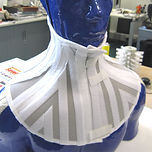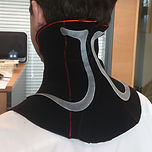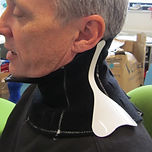alexheathreed.com
Head Up
Research and new product development of a novel cervical orthosis to support neck weakness due to neurological disease.
Motor Neurone Disease (MND) is a debilitating neurodegenerative condition affecting around 4000 people per year in the UK. It is a rapidly progressive disease, that has very high mortality levels. Patients regularly experience pain and restricted movement as a result of muscle wasting and weakness. With the human head weighing around 5kg when this occurs in the supportive tissues of the neck it causes difficulties eating, breathing, with communication and cosmesis. People living with this life-limiting disease can often not control head movements or lift their head as its mass can cause it to drop forward, backward, or side to side, often until the chin comes to rest on the upper chest.
.jpg)
MND patients demonstrate head drop without orthotic support. The need for better assistive technology this field came directly from patients and carers with the view that current neck orthosis designs were not fit for MND patient purposes.
Understanding the issues
Working with patients, their carers and health care experts, Design’s brief targeted the development of potential solutions for these individuals, exploring different approaches to head and neck support. Through individual and all stakeholder group workshops the research team began to build on clinical and physiological understandings, developing richer insights about how design proposals would also need to consider the provision of support allowing movement, the stage of disease progression, how the disease may manifest in them (an individual’s changing asymmetric strength levels for example), personal task achievement needs and desires, and address differing human body size and shape issues. Critically, these factors needed to be coupled to real world viability, both in respect to manufacturability and affordability.


Researching and designing with users Moya describes the challenges she faces and the processes the research team engaged in to build understanding and empathy. Watch the full interview video here (external link).
User and all stakeholder workshop formats to develop understandings across all groups including people diagnosed with MND, at different stages of disease progression, their carers, often family members, Occupational and Physio Therapists, clinical and scientific experts.



Experiential research methods included design, carer, clinical and neurological teams encountering end user issues when using existing product offers. The Head Up projects clinical Principal Investigator, Neurologist Professor Christopher McDermott (shown), experienced daily tasks using an existing product offer prescribed to patients with a diagnosis of MND.
Making and drawing to learn Having built an understanding of the human centred and technical challenges the team begun to use two and three dimensional design skills to explore potential solutions. These artefacts and images embodied Designs understanding of the challenges at key points in the design process, prompting further insight through subsequent stakeholder workshops. Early stage design responses to identified challenges were captured as sketches and sketch models that emit Designs understanding. One depicted (above) a concept utilising a supportive ‘scaffold’ material to which customisable support elements could be selected and attached.
Designing to ask - sacrificial concepts
A key aspiration voiced early in the research was the provision of head and neck support that allowed movement. This presented the design team with some challenges as, by virtue of the fact a mass is supported it will be, to some extent, limited in the direction of that support. Potential designs explored the paradox to help understand what this desired meant, to ask and explore how this may be achieved.


_edited.jpg)

Sacrificial concepts Exploring meaning and functionality. In one example the end user group communicated that if a product was available that supported their head to look forward and facilitate side to side movement, but to the detriment of head up and down movements, they may forgo the later. While some scepticism existed in the group the design team specified and produced a sample (far right above) that achieved what came to be regarded as the ‘R2D2’ sacrificial concept. When this design was presented back to users it became clear that head up and down movements were essential to activities of daily living, and while the exercise produced valuable insight the concept was abandoned.












Iterative design development Following selection of the of designs that met the largest range of use functionality, user acceptance and stakeholder requirements the design was taken forward through several iterative design cycles. From early conceptual modelling to a final design specification the team explored a wide range of underlying pattern and support structure configurations, each acting to support a know muscle weakness area.
Designing to validate +
The specification, design and production of testing and validation tools is crucial to this type of new product development. While often considered primarily a tool for verification purposes alone they can also be invaluable to the designer as their creation reveals and embeds further insights. In this case the development of a 'lifelike' mannequin, fondly named 'Edwood', provided invaluable understanding of many aspects of use and performance. His design further and practically informed the team about the critical structures of the neck, about ranges of head motion, the extents to which neck tissue play in supporting head kinematics, and crucial in understanding final material selection.

'Edwood' test mannequin With the average head weighing around 5 kilograms the team needed to ensure that final product materials and device configurations were capable of supporting dynamic and sustain loads. The ‘Edwood’ mannequin was specified, designed and fabricated with human like ranges of motion and variable loading systems enabling the design team to better understand potential product and material performance.
Closing
The Head Up project addressed the challenges of neck muscle wasting holistically with a unique design that spanned the real needs of users with viable technology. Materials selection and design for manufacture factors (not covered here) were paramount throughout the research to ensure fitness for purpose in hand with commercial viability. Until the marketing of now commercially available Head Up product design (see here for purchasing information) no neck orthotic was available that addressed the unique challenges MND presents. Most people diagnosed with MND and ALS (Amyotrophic Lateral Sclerosis) were prescribed one or a number of either homogeneous support or full head and neck immobilisation devices, for many not least inadequate in terms of comfort and function. The Head Up product has helped a large number of people worldwide with unit sales exceeding several thousands. As high levels of customisability are built in it is also understood to have been adopted by people living with the effects of stroke, multiple sclerosis, myopathy, cervical dystonia and individuals with neck pain due to muscular strain or arthritis. The participatory research methods used to inform the design and its positive impact have been recognised through a Special Jury Award by Made with Patients Awards in 2023, was a key example used by the Lab4Livings in support of its successful Expanding Excellence England (E3) funding application (£4M) and the work used as an impact case study in its 2021 Research Excellence Framework (REF) submission.
The cross disciplinary research programme was supported by £445K from National Institute for Health Research (NIHR) ‘invention for innovation’ (i4i) programme, involved NIHR Devices for Dignity and the Motor Neurone Disease Association, with support from Dementias and Neurodegenerative Diseases Research Network (DeNDRoN), the Clinical Studies Group for Motor Neuron Disease, Sheffield Teaching Hospitals and Barnsley NHS Foundation Trusts. Design and Design Research was led by Heath Reed at the Lab4Living (L4L) working closely with Andrew Stanton, Creative and Technical Researcher. The Neurological and Clinical teams were led by Professor Christopher McDermott at SITraN (Sheffield Institute for Translational Neuroscience).
Design and Research outcomes from this initiative include a productionised and marketed product with the flexibility to allow customisation and functional head movement during use, thousands of improvements to quality of life, associated intellectual property and a significant body of dissemination work that helps build understandings of optimal requirements for a supportive neck orthosis.
External links